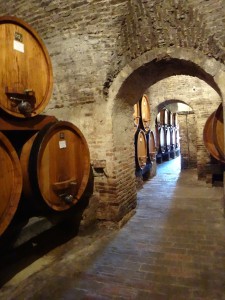Many people are familiar with Brunello di Montalcino wines, grown and produced in the Tuscany appellation of Montalcino. For many years, Brunello and Barolo each claimed the unofficial bragging rights title of “King of Italian wines”. Today, big, luscious Super Tuscans have entered this feud, too. Brunello di Montalcino had the first
victory, though, as it was the first wine in Italy to receive the coveted DOCG designation.
Fewer people, however, know that the wine Vino Nobile di Montepulciano DOCG, also produced from Tuscany’s Sangiovese grape, was the second wine to be designated a DOCG wine.
If you missed my blog on the wine designations in Italy—DOCG, DOC, IGT, and VDT, you can brush up on your wine lingo and understanding by reading DOCG, DOC, IGT, and VDT Italian Wines – What do these mean? .
The difference between Brunello di Montalcino and Vino Nobile di Montepulciano is twofold—territory and process.
Montalcino vs. Montepulciano
The DOCG designations are for a particular terrior and geographic area within Italy.
These appellations sit side-by-side in the Siena province, with the hill towns of Montalcino and Montepulciano about 35 km or 22 miles apart by scenic, curving road.
Comparison of the two appellations and their namesake towns:
Montalcino
Population: 5,118
Cases produced: 333,000
Geographic area: 12,000 ha
Montepulciano
Population: 14,389
Cases produced: 250,000
Geographic area: 820 ha

Since receiving their DOCG designation, the number of wine producers and hectares planted with Sangiovese grapes has grown dramatically in both appellations. For example, in 1960 there were 11 Brunello di Montalcino producers and 1,000 ha in vineyards. These numbers grew to 230 producers in 2006, with 12,000 ha in vineyards. The cause of the rapid expansion can be largely attributed to the expanded ability to market these fine wines (as a first a DOC and later a DOCG wine) to consumers in the United States and United Kingdom.
How does one grape turn into two distinctly different wines?
Once you account for the difference of terrior, the simplified answer is the amount of time the wine is aged and the grapes used.
Brunello di Montalcino is produced 100% from Sangiovese and cannot be released for sale until five years after the harvest. The requirements to be designated a DOCG wine is that Brunello must be aged in oak for at least 2 years and at least 4 months in the bottle before being released. Brunello di Montalcino cannot be released for sale until five years after the harvest.
Vino Nobile di Montepulciano is made at least 70% from Sangiovese, with a maximum of 20% from Canaiolo grapes and a maximum of 20% from other permitted grapes, such as Mammolo. It must be aged for 2 years from the January 1st after the harvest, with a minimum of 12 months in oak.
What about the flavor, suitability for aging, compatibility with food? Ooh, that’s for another blog, one that I must—for research’s sake—pen with a tasting glass of each by my side and perhaps even some tidbits of food.




